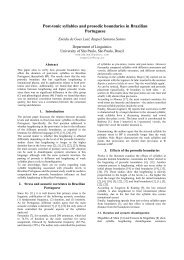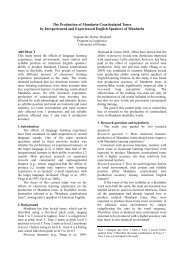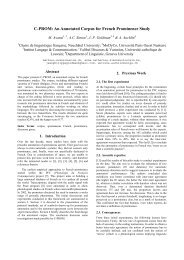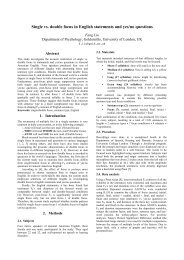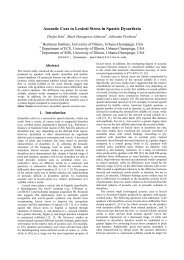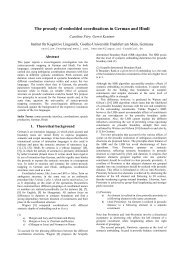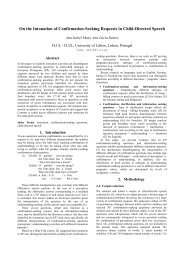Word Accent and Emotion - Speech Prosody 2010
Word Accent and Emotion - Speech Prosody 2010
Word Accent and Emotion - Speech Prosody 2010
Create successful ePaper yourself
Turn your PDF publications into a flip-book with our unique Google optimized e-Paper software.
79<br />
74<br />
EN<br />
65<br />
60<br />
AMN<br />
55<br />
50<br />
AMEN<br />
MFCC<br />
prosody<br />
all<br />
h [%]<br />
69<br />
55<br />
45<br />
64<br />
50<br />
40<br />
59<br />
-WA +WA +/-WA <strong>Word</strong><br />
45<br />
-WA +WA +/-WA <strong>Word</strong><br />
35<br />
-WA +WA +/-WA <strong>Word</strong><br />
Figure 2: Classification results per configuration (EN, AMN, AMEN) <strong>and</strong> per group of features: 97 prosody-based features (energy<br />
+ pitch + zero-crossing-rate + harmonic-to-noise ratio + duration); 288 MFCC-based; <strong>and</strong> all features together (385). Performance<br />
figures, in %, are harmonic means (h) over the classes of weighted <strong>and</strong> unweighted recalls. Error bars represent st<strong>and</strong>ard errors.<br />
spectral features by exploiting the findings in previous studies<br />
(e. g. [8]). Features are calculated using the openEAR feature<br />
extractor [9]. The whole set comprises 16 low-level descriptors:<br />
energy, pitch, zero-crossing-rate, harmonics-to-noise ratio,<br />
<strong>and</strong> the first 12 Mel-frequency cepstral coefficients. To each<br />
of them, we add the delta coefficients computed to cope with<br />
feature dynamics. Next, 12 functionals are applied on a unit basis:<br />
mean, st<strong>and</strong>ard deviation, kurtosis, skewness, minima <strong>and</strong><br />
maxima with relative positions, range, <strong>and</strong> linear regression coefficients<br />
with the regression error. Duration in frames, as obtained<br />
from the forced alignment, is also added to the feature<br />
set. The total feature vector per word or per syllable, depending<br />
on the analysis, contains up to 385 attributes (288 MFCC-based,<br />
97 prosody-based).<br />
The data are partitioned into three balanced splits (as in<br />
[8]) meeting the following requirements (in order of priority):<br />
speaker-independence, similar distribution of labels, balance<br />
between the two schools, <strong>and</strong> balance between genders. In order<br />
to have a more balanced distribution for training, we upsampled<br />
all classes but Neutral to uniform distributions.<br />
Classification results shown in Fig. 2 are obtained by 3-fold<br />
Cross-Validation (CV). As classifier we opted for Support Vector<br />
Machines (SVM) trained by Sequential Minimal Optimisation<br />
with linear kernel [10]. Parameters are optimized separately<br />
on the three different training sets also by CV.<br />
Figures of classification performance are harmonic means<br />
(h) of weighted (WA) <strong>and</strong> unweighted averaged (UA) recalls:<br />
for very unbalanced datasets like ours this reduces the spread<br />
between UA <strong>and</strong> WA. In this way we give each class the same<br />
importance, <strong>and</strong> we neither penalize sparse classes such as<br />
Motherese nor very frequent ones such as Neutral. In Fig. 2<br />
<strong>and</strong> 3 we scale the y-axis (h) differently as we are not interested<br />
in absolute performance but, mainly, in the relation between<br />
+WA, -WA, <strong>and</strong> <strong>Word</strong> across the three configurations; it could<br />
be expected that fewer classes yield higher performance.<br />
In the following discussion we also consider the accuracy<br />
of the results: st<strong>and</strong>ard errors are estimated by running the<br />
bootstrap algorithm [11], a Monte Carlo method: replications<br />
of h are obtained by r<strong>and</strong>om sampling with replacement from<br />
the training sets. Differences (in h) of at least two st<strong>and</strong>ard<br />
errors greater than zero correspond to p-values of ≃ 5%. Finally,<br />
we draw conclusions on figures that show consistency<br />
across configurations <strong>and</strong> feature sets, <strong>and</strong> should therefore be<br />
less prone to multiplicity effects.<br />
4. Discussion<br />
The results displayed in Fig. 2 confirm our H1 formulated in<br />
Sec. 1. Throughout the three different constellations, independently<br />
of the feature set, -WA syllables perform worse than all<br />
other units; <strong>Word</strong> are the best along with accented syllables<br />
(+WA). The almost identical performance of +WA <strong>and</strong> <strong>Word</strong><br />
could, to some extent, be expected as many words are made of<br />
one syllable only; but, as can be inferred from the histogram of<br />
Fig. 1, there is also a considerable number of words (≃ 30%)<br />
with two or more syllables.<br />
These results, corroborated by the mediocre performance<br />
of the mixture +/-WA, do not mean that there is no information<br />
entailed in -WA syllables that, alone, perform well above<br />
chance level. However, in combination with +WA syllables<br />
when modelling words (<strong>Word</strong>), -WA syllables do not give any<br />
added value: the small improvements (≤ 1.9%±1.2 for MFCC,<br />
AMN) are not significant for any configuration. In other words,<br />
modelling words or only syllables carrying the word accent<br />
(lexical stress) is equivalent. Also note that differences among<br />
acoustic units +WA <strong>and</strong> -WA are larger for EN <strong>and</strong> AMEN, i. e.<br />
those constellations where Emphatic is involved, <strong>and</strong> lower for<br />
AMN but still ample (≥ 7.1% ± 1.4 for MFCC).<br />
The situation is very different if we concentrate on the word<br />
‘Aibo’ only (2257 tokens). From Fig. 3 we notice that the behaviour<br />
of the acoustic units across configurations is quite similar;<br />
more specifically, the +WA syllable does not contribute<br />
more than the -WA syllable. This might be traced back to the<br />
special role of this word <strong>and</strong> its use in the interaction: ‘Aibo’ denotes<br />
the communication partner <strong>and</strong> is practically always used<br />
as vocative, i. e. produced with continuation rise, mostly without<br />
shortening <strong>and</strong>/or centralisation of the -WA syllable; cf. the<br />
notion of ‘calling contour’ [12], or ‘vocative chant’, i. e. H*!H%<br />
in ToBI notation. The duration plots in Fig. 4 clearly show this<br />
difference: for all ‘Aibo’ words there is no clear peak of -WA<br />
syllables [bo:], whereas the frequency peak for the syllables<br />
of all other words is sharper <strong>and</strong> at around 12 frames. Similar<br />
considerations hold for MFCC features alone (Fig. 3): with<br />
identical segmental information, the 2nd syllable can be modelled<br />
very consistently.<br />
In Fig. 2 we display classification results using three differ-<br />
h [%]<br />
66<br />
63<br />
60<br />
57<br />
54<br />
-WA<br />
EN<br />
+WA<br />
60<br />
57<br />
54<br />
51<br />
48<br />
-WA<br />
AMN<br />
+WA<br />
48<br />
45<br />
42<br />
39<br />
36<br />
-WA<br />
AMEN<br />
+WA<br />
Figure 3: Classification results using (-WA or +WA) syllables<br />
from ‘Aibo’ words only. Performance figures in h[%]. Error<br />
bars represent st<strong>and</strong>ard errors. Same legend as Fig. 2.



